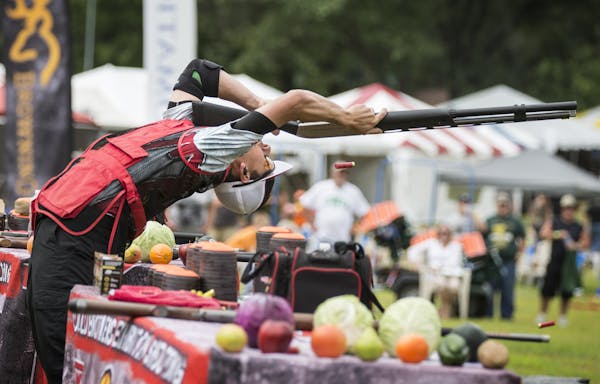A generation of Minnesota waterfowl hunters has grown up with a 60-day duck season and six-bird bag limits.
"They have no experience with a 30-day duck season [and three-bird bag limits],'' said Steve Cordts, Minnesota Department of Natural Resources waterfowl specialist.
And they're not going to see a short season this year, either.
DNR officials this week will announce another 60-day, six-duck season, which will start Sept. 26.
"It's the 19th year in a row of liberal duck seasons,'' Cordts said.
The reason: This spring's estimated continental breeding duck population was a record-high 49.5 million, causing the U.S. Fish and Wildlife Service to continue to offer hunters another liberal season. But like a constantly rising stock market, a correction is bound to happen, Cordts said.
"It's been wet for 20 years,'' he said. "At some point, it's going to be dry and we'll see a large drop in duck populations,'' forcing federal officials to scale back hunting seasons.
This year's regulations will be mostly the same as last year, except hunters will be able to kill two canvasbacks instead of one because their populations are up. The state again will be broken into three hunting zones.
Though the continental duck population is at an all-time high, Cordts said that doesn't necessarily mean Minnesota hunters will see swarms of ducks over their blinds. Weather, for one, will influence when ducks migrate through the state.
Still, Cordts, an avid duck hunter, is optimistic: "I think it should be a good year.''
How many hunters?
The U.S. Fish and Wildlife Service's annual waterfowl harvest report, which also estimates the number of active duck hunters in each state, continues to perplex state officials. The 2014 harvest report, released recently, estimated the number of Minnesota duck hunters at 65,300, a 25 percent increase from the 52,200 estimated last year.
But that came after a 33 percent decline from 2013, and the lowest number of hunters since the current survey method began in 1999.
Cordts questioned last year's drop, noting the state sold about 90,000 state duck stamps in 2013 and 2014. He figures perhaps 5 percent of those buying stamps don't hunt, meaning the state likely has about 85,000 active duck hunters.
Other states had similar discrepancies, casting doubt about the accuracy of not only the hunter numbers but duck harvest numbers, too.
"[Federal officials] are aware of our concerns,'' Cordts said. "I don't know what, if any, changes might come.''
He said federal authorities have asked law enforcement to check hunters this fall for Harvest Information Program compliance. When hunters buy their licenses, they must identify themselves as migratory bird hunters and answer several questions about their hunting experience last year.
Federal officials then randomly select a sample of those hunters to survey.
Minnesota's own hunter survey results, which also estimate number of hunters and harvest, are due out later this month.
Mallards and mergansers
Meanwhile, though the 2014 federal survey showed more Minnesota duck hunters, it also showed that the harvest fell 6 percent to 571,300 ducks, or about 8.7 ducks per hunter. Mallards were again No. 1 in the bag, with 162,000, a slight decline from 2013.
Wood ducks were No. 2 in the bag (115,000), a 23 percent decline from the year before. Blue-winged teal were No. 3 at 82,000, a 29 percent decline.
One surprise: Hunters shot 21,000 hooded mergansers, a 130 percent increase from 2013. They aren't considered prime eating fare.
"It's almost embarrassing,'' Cordts said. "We shot 10 times as many hooded mergansers as scaup. Often they are mistake birds. But I've eaten them. They're not bad.''
Hunters killed just 2,600 lesser scaup, or bluebills, a 74 percent drop from the previous year.
Goose opened Saturday
The August Canada goose hunting season opened Saturday in west-central Minnesota and runs through Aug. 23. This is the third year of the special hunt, designed to reduce the burgeoning Canada goose population and resulting crop depredation in that area.
Hunters can shoot up to 10 Canada geese per day, and there is no limit to the number they can possess.
Last August, about 5,500 hunters harvested about 21,000 Canada geese, compared to 24,000 in 2013.
Ontario restrictions
Because of avian flu concerns, waterfowl hunters who travel to Ontario to hunt apparently won't be able to bring their ducks or geese back. Earlier this year restrictions were placed on importation of avian products from Ontario, which would include migratory game birds killed by hunters. Ontario's waterfowl season begins the first week in September.
Get more information at tinyurl.com/k2laqdz.
doug.smith@startribune.com
Twitter: @dougsmithstrib
Verstappen takes pole for Chinese GP to extend F1 dominance. Hamilton 18th
Jordan Montgomery wins in debut, Diamondbacks get 22 hits in 17-1 win over Giants
Ingram, Valanciunas lift Zion-less Pelicans past Kings and into the playoffs
Justin Turner's homer, RBI single highlight Blue Jays' 5-1 win over the Padres
![Minnesota Twins pitcher Jhoan Duran (59) in the ninth inning Tuesday, August 15, 2023, Target Field in Minneapolis, Minn. ] CARLOS GONZALEZ • carlos](https://arc.stimg.co/startribunemedia/NWLT5CNXGTRZA6KVTMIPSOG3KI.jpg?h=91&w=145&fit=crop&bg=999&crop=faces)
